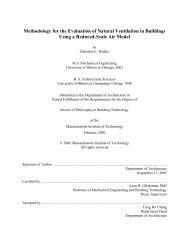Print Version - Center for the Biology of Natural Systems
Print Version - Center for the Biology of Natural Systems
Print Version - Center for the Biology of Natural Systems
You also want an ePaper? Increase the reach of your titles
YUMPU automatically turns print PDFs into web optimized ePapers that Google loves.
D22303YI ET AL.: DRAINAGE FLOW MODELD22303The shear production rate is usually expressed asP s ¼u 0 w 0 @u@z :ð19ÞThe ratio <strong>of</strong> <strong>the</strong> wake and shear production rates is <strong>the</strong>re<strong>for</strong>eP w¼ u @u0 w 0@zP s u 0 w 0 @u : ð20ÞSubstituting equations (2) and (3) into equation (20), <strong>the</strong>ratio is reduced to@zP w¼u@c D=@zP s c D @u=@z þ 2 : ð21ÞFigure 9. Half-hour average <strong>of</strong> SF 6 concentrations at fourtowers during <strong>the</strong> period 0146–0504 LT on 8 August 2002.During <strong>the</strong> observation period we observed <strong>the</strong> typicalS-shaped wind pr<strong>of</strong>ile (see Figure 10) and <strong>the</strong> meanObukhov stability was calculated as z =(z d)/L 5.87,indicating highly stable atmospheric conditions above <strong>the</strong>canopy (at 21.5 m).optimal per<strong>for</strong>mance, we made observations <strong>of</strong> verticaldispersion at all four observation towers (Figure 9). Therewas clear sharp stratification among even <strong>the</strong> lowest observationlayers on <strong>the</strong> WT tower only 50 m downslope from<strong>the</strong> release line, indicating <strong>the</strong> presence <strong>of</strong> a thin downslopeflow with little upward mixing. By <strong>the</strong> time <strong>the</strong> tracer-ladenair reached <strong>the</strong> lower towers, <strong>the</strong>re was evidence <strong>of</strong> somevertical mixing to <strong>the</strong> 6 m layer, but essentially none in <strong>the</strong>layers above 8 m, even at <strong>the</strong> lowermost tower, 200 mdownslope from <strong>the</strong> release line. At <strong>the</strong> south tower (ST)and north tower (NT) we only made observations at <strong>the</strong>lowest vertical levels; however even at <strong>the</strong>se levels, <strong>the</strong>rewas sharp stratification between <strong>the</strong> lowest and highestlevels.4.4. Wake-to-Shear Production Rate as a PossibleCause <strong>of</strong> <strong>the</strong> Within-Canopy Stable Layer[21] We hypo<strong>the</strong>sized that <strong>the</strong> stable, within-canopy layeris due to a localized region <strong>of</strong> high wake-to-shear productionratio. We explored this hypo<strong>the</strong>sis using <strong>the</strong> analyticalmodel. Ignoring <strong>the</strong> slope-dependent term in equation (1)we can writeThus <strong>the</strong> ratio can be estimated on <strong>the</strong> basis <strong>of</strong> <strong>the</strong> windpr<strong>of</strong>ile presented in Figure 3 and <strong>the</strong> drag coefficient pr<strong>of</strong>ilepresented in Figure 4. Qualitatively, <strong>the</strong> vertical gradient <strong>of</strong><strong>the</strong> drag coefficient is almost opposite to that <strong>of</strong> wind speed.If <strong>the</strong> wake-to-shear production ratio is physically limited tobe positive, <strong>the</strong>n it should be <strong>the</strong>oretically less than or equalto 2.[22] The ratio <strong>for</strong> <strong>the</strong> upper part <strong>of</strong> <strong>the</strong> canopy calculatedby equation (21) based on <strong>the</strong> wind and drag coefficientpr<strong>of</strong>iles is shown in Figure 11. Calculated values wereindeed less than 2, except in <strong>the</strong> lowest part <strong>of</strong> <strong>the</strong> canopy,where equation (21) may not be valid because @u/@z 0.The maximum wake-to-shear production rate appears near<strong>the</strong> canopy height <strong>of</strong> maximum leaf density level ra<strong>the</strong>r thannear <strong>the</strong> top <strong>of</strong> canopy as has been shown in wind tunnelexperiments [Raupach et al., 1986]. The relative wakeproduction rate decreases linearly to zero from near <strong>the</strong>maximum leaf area density level to <strong>the</strong> top <strong>of</strong> canopy;following <strong>the</strong> decrease in leaf area density that occurs in <strong>the</strong>upper canopy layers <strong>of</strong> <strong>the</strong>se conically shaped trees. Weinterpret this pattern as reflecting <strong>the</strong> fact that wake turbulenceis caused by <strong>the</strong> small-scale pressure gradient associatedwith canopy elements and hence depends on leaf areadensity.@u 0 w 0@z¼c D ðÞ‘ z ðÞu z2 ðÞ¼f z D :ð17ÞPhysically, <strong>the</strong> drag <strong>for</strong>ce (<strong>for</strong>m drag) f D is a directconsequence <strong>of</strong> noncommutation <strong>of</strong> differentiation and areaaveraging over a horizontal plane that intersects numerousplants, producing <strong>the</strong> pressure <strong>for</strong>ce [Wilson and Shaw,1977; Raupach et al., 1986]. The wake turbulent productionrate is <strong>the</strong> work done by <strong>the</strong> flow against <strong>the</strong> <strong>for</strong>m drag andcan be written asP w ¼ uf D ¼ u @u0 w 0: ð18Þ@zFigure 10. Half-hour average <strong>of</strong> wind speed at <strong>the</strong> WTtower during <strong>the</strong> same period as <strong>the</strong> SF 6 was observed inFigure 9.8<strong>of</strong>13
















